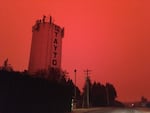People with or recovering from COVID-19 need to use extra caution when it comes to their health as wildfire smoke blankets large areas of Oregon.
“Those folks are individuals that we would be concerned about,” said Jackson County Public Health program manager Tanya Phillips. She’s one of several public health officials concerned about the combined effects of fires and the pandemic.
High winds caused several Oregon fires to expand rapidly Tuesday and over the holiday weekend. Air quality conditions were categorized as hazardous in several parts of the Willamette Valley connected to the Beachie Creek Fire east of Salem. There were spikes of unhealthy air quality in southern Oregon as well from the Two Four Two fire burning near Chiloquin.
“[COVID] really does impact the heart and lungs, so that may be compromised. Which then when you put poor air quality on top of that, it’s going to exacerbate those symptoms,” she said.

Wildfire smoke in the Santiam Canyon turns the morning sky red on Sept. 8, 2020 in Stayton.
Cassandra Profita / OPB
The Oregon Health Authority echoed this sentiment in information published Saturday.
Phillips said that the best strategy for people in this situation is to stay indoors when air quality conditions deteriorate because of wildfire smoke. This advice holds true for those who are especially sensitive to wildfire smoke for other reasons as well – including children and older adults, pregnant women, people with asthma or other lung and heart conditions.
Officials in Ashland distributed around 500 home air filters to community members earlier this summer in an attempt to get out ahead of issues surrounding wildfire smoke.
In addition, the Centers for Disease Control and Prevention says that smoke from wildfires can “irritate your lungs, cause inflammation, affect your immune system, and make you more prone to lung infections, including SARS-CoV-2, the virus that causes COVID-19.”
Research from Harvard University found in April that increased quantities of PM 2.5 increases the rate of death from COVID-19. PM 2.5 is the tiny particulate matter in smoke and other pollution that can penetrate deep into the lungs. These particles have been linked to short- and long-term health effects.
An August study in the American Journal of Public Health modeled what the impact of wildfire smoke would have been during the outbreak of COVID-19 in Washington state earlier this year.
“Simply put, a wildfire smoke episode of moderate magnitude and intensity has the potential to increase the impact of a COVID-19 outbreak by approximately 10%,” University of British Columbia’s Sarah Henderson wrote in the paper, adding that the hypothetical timing of a wildfire in relation to the timeline of the outbreak would make a considerable difference in its impact.
The CDC says the cloth masks that are being used to prevent the spread of coronavirus through respiratory droplets don’t offer much protection against the particulate matter in wildfire. The smoke particles are too small to be stopped by the fabric, although well-fitting N95 masks do filter out smoke particles.
Officials also expect there to be COVID-19-related challenges if emergency shelters are needed to house wildfire evacuees. Unless significant accommodations are put in place, maintaining social distancing in temporary shelter would likely be difficult.
